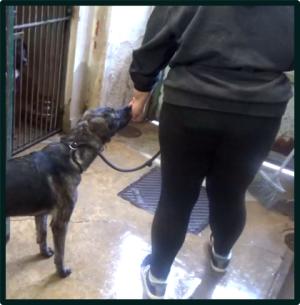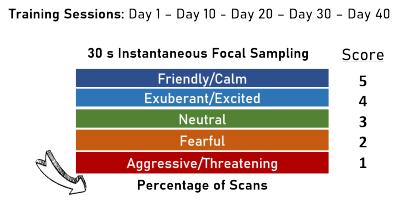Social Rehabilitation & Leash Training Protocols
The social rehabilitation and leash training protocols essentially consisted of systematic desensitization and counter-conditioning procedures, together with procedures of positive reinforcement of desired behaviours (Overall, 2013). The protocols were constructed in a way to reduce the stray dog's initial condition of fear in response to interactions with humans and also towards a leash (counter-condition) (Butler et al. 2011).
Social Rehabilitation

The social rehabilitation protocol comprised eight phases that were common to Group C2 and Group Stray (phases 1 to 8) and an additional phase for Group Stray (phase 9). Two training sessions were performed per day, from Monday to Friday. Each training session lasted approximately 10 minutes, and a 60-minute break was included between them. Whenever the dog demonstrated the desired behaviour for the current training phase, on the following day the dog was moved to the next phase of the protocol.
Phases:
- Throw food near the dog
- Throw food into the centre of the cage
- Throw food near the entrance of the cage
- Reinforcing movement
- Moving towards the dog
- Reinforcing movement towards the trainer
- Offer food by hand
- Trying to touch the dog
- Reinforcing exiting the enclosure (Only for the Stray Group, Figure 11)
Leash Training

The leash training protocol comprised five phases that were common to Group C2 and Group Stray (phases 2 to 6) and an additional phase for Group Stray (phase 1) . For this protocol, one daily training session of 10 minutes was performed from Monday to Friday. Whenever the dog demonstrated the desired behaviour for the current training phase, on the following day the dog was moved to the next phase of the protocol on the following day.
An extra phase was added for the stray dogs Molly and Nina, as they were in a more advanced phase of the protocol and the door of the room where their enclosure were in seemed to be an obstacle for further progress.
Phases:
- Reinforcing exiting the enclosure (Only for the Strays)
- Eating from the hand
- Luring to follow hand movement
- Presenting Leash
- Putting the Leash
- Walking inside the test area
Extra: *Going to the test area* - Nina & Molly (Strays)
Phase Progression & Body Posture Analysis
The phase of the protocol and behaviour of the dogs during the social rehabilitation and leash training were recorded at five time-points (T1, T10, T20, T30 and T40) with ten days apart. The first time point corresponds to the first session of the protocol, the second time point was recorded ten days after and so on until the fifth time point, which was the last session of the protocol. For the social rehabilitation, the camera was put in the direction of the enclosure of the animal at a distance that allowed to capture the familiar person and the animal. For the leash training, the same procedure was done, except when the dogs were in the last phase of the protocol, as the unfamiliar person helped film the training, holding the camera and walking behind the familiar person and the dog being trained.
The recordings were analysed using 30-seconds instantaneous focal sampling method, attributing a score of 5 if the dog was friendly and calm, a scored of 4 if it was excited and exuberant, a score of 3 if the dog was neutral, 2 if it was fearful and 1 if the dog was in an aggressive or threatening body posture. The count of scans for each position was divided by the count of the total scans, resulting in a percentage of scans (see Figure 12)

Responsible for this page:
Director of undergraduate studies Biology
Last updated:
06/01/20
